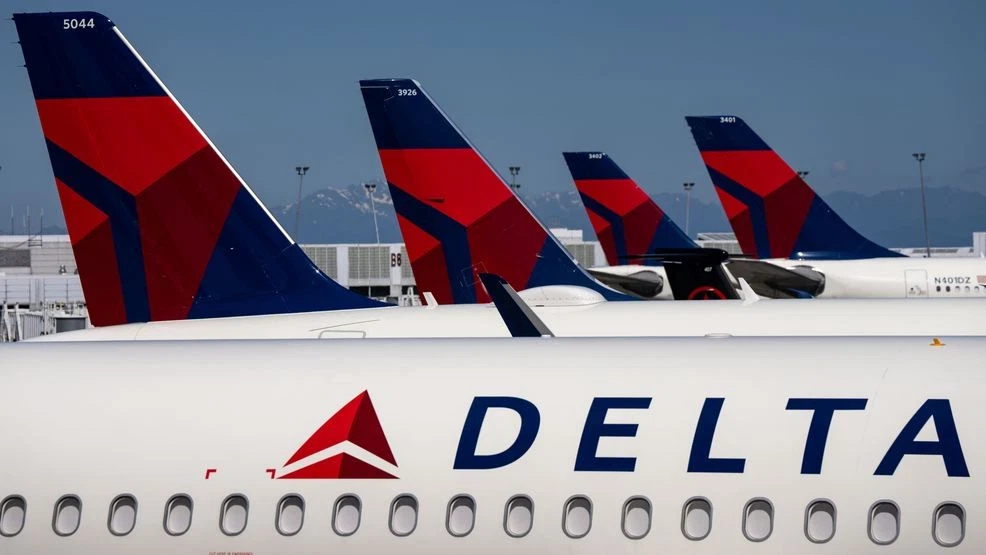A routine trans-Pacific flight turned into a remarkable display of aviation safety and precision decision-making. Delta Flight DL275 Diverted LAX, an Airbus A350-900, was forced to make an emergency diversion to Los Angeles International Airport (LAX) due to a critical engine anti-ice system failure.
This incident is more than just a technical glitch—it’s a lesson for the future of aviation, underlining the importance of predictive maintenance, AI monitoring, and crew professionalism. While all passengers landed safely, the event spotlighted both vulnerabilities and opportunities for the industry.
Delta Flight DL275 Diverted LAX: The Full Story
Delta Flight DL275 Diverted LAX, operated by Delta Airlines, departed from Seoul Incheon Airport (ICN) bound for Atlanta (ATL). About 620 nautical miles southwest of Anchorage, at an altitude of 38,000 feet over the North Pacific, the crew detected a malfunction in the Rolls-Royce Trent XWB anti-ice system.
Recognizing the risk of ice accumulation in freezing conditions, the pilots declared an emergency and executed a controlled diversion to Los Angeles International Airport (LAX), which offers 24/7 A350 maintenance capability and Rolls-Royce-certified technicians.
Technical Breakdown: Why the Anti-Ice System Failed
Rolls-Royce Trent XWB Overview
The Trent XWB is a state-of-the-art engine powering Airbus A350 aircraft. It includes an advanced anti-icing mechanism that uses heated bleed air to prevent ice formation on critical components like fan blades and inlet guide vanes.
Role of Anti-Ice Systems in Aviation Safety
At cruising altitudes, temperatures can plunge below -60°C, making anti-ice systems essential. Failure of this system can cause thrust loss, which is unacceptable for long-haul transoceanic routes.
What Triggered the Emergency
Sensor data later revealed anomalies:
- Oil pressure dropped by 25%
- Vibration levels surged by 60%
- Anti-ice flow rate halved (from 10-15 gal/min to 5 gal/min)
These deviations could have been flagged hours earlier with AI-driven predictive systems.
Emergency Response: How the Crew Handled It
Pilot Decision-Making
The crew’s swift response adhered to FAA emergency protocols, ensuring safety above all else. Rather than risking further flight over the Pacific, they chose LAX for its long runways, technical support, and Delta operational hub.
ATC provided priority routing for DL275. The Airbus A350 touched down safely on Runway 06R after nearly five extra hours in the air.
Passengers remained calm, thanks to clear communication from the crew and Delta’s efficient customer service and rebooking process.
Financial Impact of Delta Flight DL275 Diversion
The diversion wasn’t cheap. Estimated costs include:
| Expense Category | Cost |
|---|---|
| Extra Fuel for Diversion | $500,000 |
| Landing Fees at LAX | $50,000 |
| Maintenance & Inspection | $300,000 |
| Passenger Rerouting | $800,000 |
| Accommodation & Meals | $400,000 |
| Total | $2,050,000 |
Including revenue loss from the canceled Tokyo segment, the figure exceeded $2.3 million.
Could Predictive Maintenance Have Prevented It?
AI and Machine Learning in Maintenance
Modern aircraft generate 2.5 TB of data per flight. AI-powered health monitoring systems can analyze:
- Oil pressure trends
- Bleed air performance
- Anti-ice valve actuation times
Reactive vs Predictive Maintenance
| Approach | Cost | Detection Timing | Prevention |
|---|---|---|---|
| Reactive | High | After Failure | Low |
| Scheduled | Medium | Periodic Checks | Moderate |
| Predictive | Low | Pre-Failure | High |
Predictive systems could have detected anomalies 3–6 hours before departure, preventing the entire event.
Airlines Leading in Predictive Technology
Lufthansa
Their AVIATAR platform processes 42 billion data points daily, reducing unexpected failures by 78% and saving $127M annually.
United Airlines
Reduced unplanned maintenance by 35%, saving $18M yearly through AI-driven monitoring.
Singapore Airlines
Achieved 95.8% fleet availability and 41% reduction in unexpected component failures.
Cybersecurity Challenges for Connected Aircraft
As aircraft become digitally integrated, risks rise:
- Data breaches
- System manipulation
Solutions include:
- Zero Trust Network Architecture
- End-to-end encryption
- AI-based anomaly detection
Regulatory and Certification Challenges
The FAA and ICAO require tens of thousands of operational hours for AI-based systems to be certified. The lack of harmonized global standards slows implementation, but industry working groups are pushing for change.
Future of Aviation Safety After Delta Flight DL275
Emerging Technologies
- Quantum computing for predictive analytics
- Blockchain for maintenance records
- 5G connectivity for real-time monitoring
This incident will accelerate the adoption of predictive maintenance, making diversions like this rare in the future.
FAQs on Delta Flight DL275 Diverted LAX
Why was Delta Flight DL275 Diverted LAX?
Due to a Rolls-Royce Trent XWB anti-ice system failure at 38,000 feet over the Pacific.
How much did it cost Delta Airlines?
Estimated $2.3 million, including fuel, rerouting, and passenger care.
What engine was affected?
The Rolls-Royce Trent XWB engine on an Airbus A350-900.
How does predictive maintenance help?
By using AI and machine learning to detect failures before they occur, we can reduce diversions and save millions.
Conclusion
The Delta flight DL275 diverted LAX incident is a wake-up call and an opportunity. It shows:
- The brilliance of crew response
- The critical role of predictive maintenance
- The need for faster AI adoption in aviation
The future belongs to airlines that embrace technology for safety, efficiency, and customer trust.



